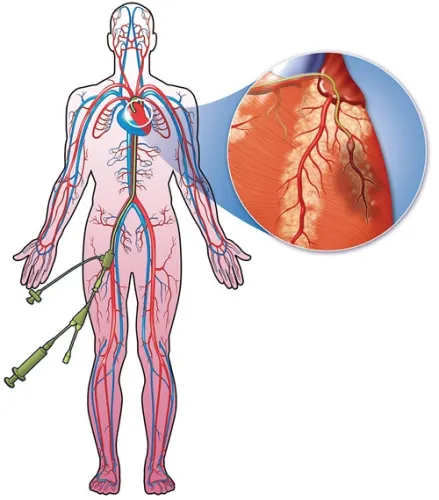Master Your Swan-Ganz Coding with These 3 Tips
See when to bundle CVA. Many clinical scenarios call on vascular surgeons to use a diagnostic Swan-Ganz catheter, but the ins and outs of coding the work may stump you. Let our experts guide you through the snags to make sure you always submit air-tight Swan-Ganz claims. Distinguish Vascular Access Clinicians use the Swan-Ganz catheter (SGC) for specific hemodynamic monitoring and central access. The SGC catheter has multiple ports for central circulation access, including a regional anesthesia (RA) port, a pulmonary artery (PA) port, a central venous pressure (CVP) port, and possibly a main line or “introducer.” The catheter is tipped with an inflatable balloon to facilitate placement in the pulmonary artery through the blood flow. The surgeon introduces the catheter through a large vein, typically the internal jugular, subclavian, or sometimes the femoral vein. Monitoring: Once inserted, clinicians can use the SGC to measure CVP, right atrial pressure, pulmonary artery pressure, as well as cardiac output and venous oxyhemoglobin saturation (SvO2), allowing calculations of metabolic parameters such as oxygen consumption and pulmonary vascular resistance. Glossary: Don’t let different terminology in the documentation fool you. You might see the Swan-Ganz catheter referred to as a pulmonary artery catheter (PAC), according to Kelly D. Dennis, MBA, ACS-AN, CAN-PC, CHCA, CPMA, CPC, CPC-I, owner of Perfect Office Solutions in Leesburg, Florida. You might also see the SGC described as a balloon flotation flow-directed catheter. “Vascular surgeons might use different catheters for other diagnostic or therapeutic purposes, and you need to distinguish those services,” says Terri Brame Joy, MBA, CPC, COC, CGSC, CPC-I, billing specialty subject matter expert at Kareo in Irvine, Calif. For instance, the surgeon might place a central venous access (CVA) catheter, typically through the superior vena cava, to measure CVP or for fluid delivery to adjust blood volume or for drug infusion. Surgeons might also place a central arterial line for transfusion or for monitoring blood pressure. You should be familiar with the following three codes so that you’re prepared to report these cases: Know Bundling Rules You might find op reports that mention several different kinds of catheters, and you’ll need to unravel which are or aren’t separately reportable. Seeing documentation of other lines placed in addition to the Swan-Ganz doesn’t automatically mean you can report each line separately. Pay attention to the details to verify what you can legitimately code. For example: While placing a Swan-Ganz catheter, the vascular surgeon might thread it through a CVA line. National Correct Coding Initiative (NCCI) edits list the CVA line (36555 or 36556) as part of the Swan-Ganz procedure. Because of this, you normally report only the Swan-Ganz placement with 93503 instead of coding for both lines. But the surgeon might place a Swan-Ganz line to monitor cardiac output and place a separate CVA line at a different location based on the need for multiple intravenous access ports. Exception: You can report both the CVA and the Swan-Ganz if your provider documents separate locations and separate line placements for the central line and Swan-Ganz catheter. Append modifier 59 (Distinct procedural service) or an appropriate X{ESPU} modifier to the central line code to override the edit pair. More bundles: After inserting a Swan-Ganz catheter, the surgeon often performs a chest X-ray to confirm proper placement and positioning of the flow-directed catheter. NCCI bundles codes such as 71045 (Radiologic examination, chest; single view) with the Swan-Ganz 93503 code, so you should not additionally report a chest X-ray. Here’s why: “Without new symptoms or other documented cause, you should always bundle standard diagnostic procedures as part of the primary procedure, such as electrocardiograms(EKGs) and X-rays that the provider performs pre and/or post procedure to verify the work,” Brame-Joy says. Other NCCI edits with 93503 that you should know include the following codes: Don’t miss: Because providers may perform a right heart catheterization with a Swan Ganz catheter, you might be confused about whether to report 93503 or 93451. “A good way to tell is if the documentation shows that the provider inserts the SGC, takes hemodynamics, but does not remove the catheter, but leaves it inserted for hemodynamic monitoring, you’re dealing with 93503 instead of 93451,” Brame-Joy says. Focus on Reason for Procedure Your provider should document the specific reason for Swan-Ganz monitoring. Review the patient’s chart and medical history for potential diagnoses that would support medical necessity. Although the advent of newer non-invasive technologies such as echocardiography may supplant Swan-Ganz in some cases, clinicians often still use SGC for the following circumstances: As such, you might see diagnoses that indicate medical necessity for SGC such as the following: 





